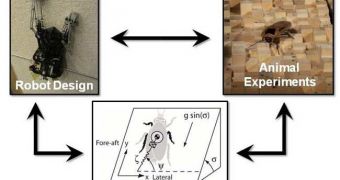Cockroaches and similar insects may seem disgusting and disease-ridden to some people, but for scientists working in the field of robotics, they are the perfect source of inspiration. Most of the designs revolving around robotic locomotion are based on the way these creatures run. According to experts, millions of years of evolution have allowed cockroaches to develop the perfect running mechanisms, allowing it to escape predators and other dangerous situations, and live another day.
One of the main goals in robotic right now is the development of machines that can use legs to easily navigate even the roughest terrain, even better than humans do. In order for this to become possible, science needs to look at the best adapted creature for this job, Oregon State University (OSU) School of Mechanical, Industrial and Manufacturing Engineering assistant professor John Schmitt says. “I take my inspiration wherever I can get it,” he reveals, adding that he is currently working on legged robots that move in the same patterns cockroaches do.
One of the main things the researcher finds incredible about the insects is the fact that they appear to be running without actually thinking about it. Even when met with blocks three times higher than their own hips, the creatures rarely slow down. Usually, they only decelerate by about 20 percent, and manage to escalate the boulders with little apparent effort. The same can be said about the Guineafowl, a bird that can also run over impressive obstacles without giving it too much thought. The cockroaches' “remarkable locomotion performance has more to do with how they are built, rather than how they react,” Schmitt argues.
In order to understand how nature evolved this type of running, the OSU research team is currently compiling computer models of the various aspects involved in locomotion. For example, the simulations account for the changes in surface properties, such as steepness and roughness, and then determine how this changes leg angles, sensor perception, feedback requirements, as well as energy expenditure and storage. If these factors interact harmoniously and within certain limits, then robots become able to navigate rough terrain as skillfully – or even more so – as cockroaches. But the work has broader implications. “Hopefully, we could produce better prosthetic devices than the ones we now have,” Schmitt concludes, quoted by LiveScience.

 14 DAY TRIAL //
14 DAY TRIAL //